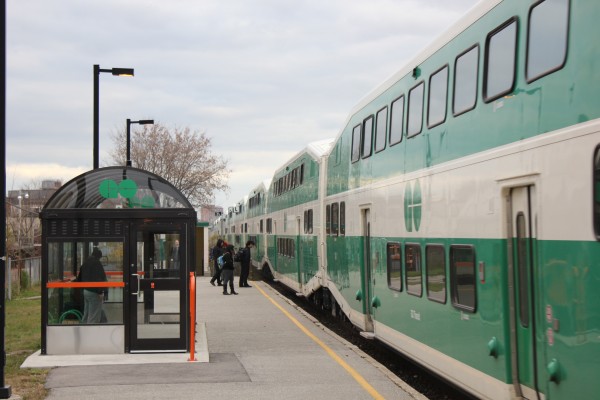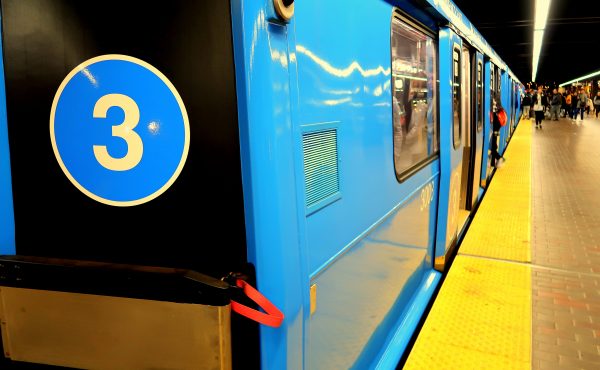By next spring, business class jet-setters who rely on Pearson Airport will be able to enjoy a direct, 25-minute link between Toronto’s largest airport and its busiest transit hub at Union Station. The four-stop UP Express — with additional boarding at Bloor and Weston GO stations — will be a smooth, high-quality, Wi-Fi equipped public amenity, with service every 15 minutes. The price of admission, an estimated $20-30.
Sound steep? Catch a bus.
For Toronto city councillor Josh Matlow, that smacks of two-tiered transit planning.
“Torontonians have been waiting for generations for a rapid transit link to our international airport,” Matlow says. “And the UP Express system has been touted as something that we should all be excited about — that it’s going to be ready for the Pan Am Games — and then we’re being told that it’s simply a boutique line for visiting business travelers. That’s not acceptable.”
Moreover, Metrolinx may be pricing themselves out of the market. For his own family, Matlow says, it would actually be cheaper just to spring for a cab.
Matlow will bring a motion before city council this month which recommends requesting Metrolinx arrive at a fare more competitive with other forms of transportation to the airport. As well, the motion recommends requesting the Greater Toronto Airports Authority drop their additional $1.85 fee, per rider, which Metrolinx agreed to implement to compensate the GTAA for the expected loss in parking revenue the express line would create.
“It’s one thing to pay for parking,” he says. “But to pay to not park is just innane.”
Matlow credits Metrolinx with a history of responding to council resolutions like the one he’s proposing.
“We need to engage Metrolinx about the importance of creating a line that is affordable and fair to Toronto residents.”
Anne Marie Aikins, spokesperson for Metrolinx, says decisions about pricing have yet to be made, but the transit agency is looking at a range of possibilities, such as reduced prices for riders boarding at Bloor or Weston.
“We will have variable pricing, but not only for distance,” says Aikins. “We’re looking at families, for groups, for children, for seniors, and for frequent users.”
Aikins says Metrolinx has done their research, but “the proof will come in the pudding.”
“We need to ensure that it’s as economically viable as possible, so that’s what we’re doing now: trying to work through all the variable pricing.”
And, while the line was designed for business/frequent travelers and visitors, Aikins says the agency wants to ensure the line will be accessible to as many people as possible, but that there are still a range of alternative options for would-be flyers, such as TTC or GO buses.
“This is just another option,” Aikins says.
The story of the UP Express, throughout its development, has been plagued with missed opportunities. It could have, for instance, been electrified by time of completion. This, Junction Triangle residents argued for years, would reduce diesel emissions in their neighbourhood, as well as remove the need for the planned 5-metre high sound walls. Currently, the plan is to electrify the line after the pre-Pan Am grand opening, necessitating a substantial retrofitting.
In terms of the service model, Matlow would have liked to see a connection between the UP Express, and the Eglinton Crosstown, currently under construction — something he says was part of the original plan. Still others would have liked to see more stops, so the line might double as added Toronto transit, and not simply a ride to the airport.
None of these additions or alterations are on the horizon, Aikins says, as the selling point for the express line is the competitive, 25 minute travel time.
Ward 16 candidate Jean-Pierre Boutros, who was a top aide to former TTC Chair Karen Stintz, recalls Stintz’s rejected 2012 OneCity transit plan proposed making the line — which would become the UP Express — an Etobicoke express commuter route. The reasoning being, Boutros says: nobody knew if the air-rail link would be viable in five years’ time. Now the investment has been made, Boutros says, and it’s up to Metrolinx to arrive at a sustainable business model.
“It’s not going to work at 25 or 30 dollars,” says Boutros. “It just simply won’t. It’s as simple as that. The price point that you can make an argument for: 15 to 18 dollars. But that’s up to Metrolinx.”
Spacing put the call out over Twitter, to get our readers’ take on the expected fare. Some were attracted to the speed, and others had no issue with the price. But, to many, the cost to ride seems exorbitant. Still others, who are able to expense their business travel, ventured they’d likely spring for the door-to-door service a taxi or limo can provide, for an average of roughly $50.
@spacing Cost me $46 from Roncy for door to door service. Train would need to cost about ~$16 to be attractive.
— bendit (@bendit) August 19, 2014
@Spacing I live right near Bloor GO. Would consider it if company paid, but would just take TTC out of pocket. — Vic Gedris (@vgedris) August 19, 2014
@Banquos_Banquet if I’m travelling for work, I’m reimbursed for cab/Town Car. I wouldn’t bother with the UP Express. — heather (@LadySnarksalot) August 19, 2014
@meslin @Spacing The odd thing about targeting business executives is they don’t care about cost and probably prefer door to door limo/taxi — Matt H (@EyesOnToronto) August 19, 2014
.@Spacing Heathrow-London express is $38 economy one-way; $95 business class return. $30 UP Express seems reasonable
— Donald P Walker (@donaldpwalker) August 19, 2014
However you may feel about the fare, as Aikins points out, any additional public transit goes a long way towards easing congestion on our roads. Metrolinx expects the new line to take 1.2 million car trips off the road in first year of operation alone. And an email to Spacing from newly-minted Transportation Minister Steven Del Duca points to comparable fares for airport express lines in London, Oslo, and Tokyo.
Still, after all the fanfare, the breathless, celebratory YouTube videos (later removed), the “well-appointed and welcoming interior”, and the $456-million price tag, it does kind of sting to be told: there’s always the bus.
Photo: Glyn Bowerman




17 comments
“Oh, crap, something’s almost gotten built around here! Quick, maybe we can demand price controls that’ll kill it off!”
I assume that at least one mayoral candidate has promised to cancel it already, and I just haven’t heard about it, yet.
A cab between our house (Pape & O’Connor) and the airport is roughly $70, maybe more. So for a single traveller this is a good price & I’d do it. If my partner and I both are headed to catch a flight, we probably split the cost on a cab for a bit more in order to have door-to-door service. On the other hand when there’s no hurry I’ve gladly taken the 90 minute TTC ride for $3 in past as well. The Express may be a touch pricey but not outrageously so. I think $20 or $22 would be the sweet spot.
The speculation isn’t going to stop but can we at least stop the unnecessary criticism until the fare is actually revealed?
As for a “cheaper” option here are 5 from Toronto:
1. Take the subway to Kipling then the Airport Rocket.
2. Take the subway to Lawrence West then take the TTC bus. If enough people do thus then TTC could add a Lawrence West Rocket.
3. Take the subway to Yorkdale then take the GO bus.
4. Once surface construction for the Eglinton Crosstown is finished, introduce an Eglinton West Rocket that would run out of Eglinton West to the Airport
5. Once two-way all-day GO Train service starts on the Kitchener line, put an “airport shuttle” at Malton GO.
http://stevemunro.ca/wp-content/uploads/2014/08/Express_Route_Network_Aug_14.jpg This map of proposed express routes show the Lawrence West-Airport and Eglinton West Rockets … so it can happen.
Cheers, Moaz
Anne Marie Aikins:
“However you may feel about the fare, as Aikins points out, any additional public transit goes a long way towards easing congestion on our roads. Metrolinx expects the new line to take 1.2 million car trips off the road in first year of operation alone.”
The MTO’s latest 5-year TTS 2011 Survey shows City of Toronto & Mississauga combined have 13,797,800 trips over 24 hours, so seriously folks, why does Metrolinx spend millions of dollars on production and media time for flashy UPExpress & GO Transit TV ads saying they, and “other Rapid Transit” will reduce congestion and have their Media Relations Manager parrot the canard “More public transit = less congestion” when UPX’s when UPX’s 1.2M annual reduction in car trips is a pittance {1.2M-year÷(13.797800Mtrips x 364days/yr)} = 0.02% of annual car trips?
With GTHA population growth of ~100K/yr, the growth in GTHA vehicles/trips overwhelms the minuscule contribution of UPX’s 1.2M annual car trip reduction—regardless of the price of its ticket.
As a reality check, over 10 years (2003/2013), GO Transit rides grew ~47% (65.3M) & TTC rides ~29% (525M), so according to Metrolinx’s theory, more transit must mean GTHA congestion eased (ie. went down) 2003/2013, RIGHT? They wouldn’t lie to us would they?
I’ll leave the reader to answer both questions!
The Neptis Foundation assumed an UPExpress average fare of $15, and had some pretty creative promotional fare ideas: https://dl.dropboxusercontent.com/u/88331870/TTC_Fares_%26_Factsheet/Welcome.html
Metrolinx’s silence on planned fare UPX suggests they’re not embracing Neptis’ ideas.
They do after all have to payback the ~$456M cost…all to speed airport trips for the Ivy League, UCC/private school olds boys & Bay Street Buds of Metrolinx’s (BMO Bank, Tory’s LLP) elitist Chair.
Priced off the Market…
Done their homework? The Auditor General did not think so: http://www.auditor.on.ca/en/reports_en/en12/309en12.pdf
Start on page 207.
By the way the 1.2 million car trips taken off the road is pure speculation. Metrolinx has never provided any data to back this up and does not take into account Braess’s paradox.
This is what you get when you put Liberals in charge of transit. Overpriced, overbudget, two tiered. Enjoy Toronto. You bought it. Four more years!
Public funding to subsidize a service for the elite and wealthy. A new rail link that goes through neighbourhoods desperate for better transit but will be practically useless to them. Electrification and more stops would have added some time to the trip, but actually created public infrastructure that served Torontonians as well as “business travellers”. What a bloody waste.
$25 to $30 is unreasonable. If they went with say $4.50 maybe $6.50 it would draw a lot more customers. It would also grab a lot of folks who work at the Airport, but live in the city.
Metrolinx estimates about 5,000 people a day will use the service.
http://metronews.ca/news/toronto/1133642/pearson-employees-upset-over-potentially-high-cost-of-up-express/
The much shorter Dufferin bus carries 39,700 daily and didn’t cost hundreds of millions to build. One GO train carries 1,200 people.
Collenette’s original promise was that the private sector would build the line without costing a public cent, thus the private sector (only SNC bid) should determine stations, pricing & service plan. Once the government realized that it was spending hundreds of millions of public dollars to build the line, it should have decided to make it public transit. Instead it tried to hide the costs by mixing them with GO expansion.
SNC likely realized it couldn’t make the line profitable at any price, and so requested that the government guarantee it operating profits. This finally prompted government to pull the plug on SNC, but they kept their private transit game plan.
The media interest and Matlow’s motion provide some hope.
If it is built for the business crowd, setting the fare so steep, then the fast train to extinction will be because the business crowd can easily afford the taxi or the limouzine, both just as fast. As for the exclusion of the rest of us intimidated by high price, then the fast train will go over the cliff sooner than anticipated.
It should be remembered that that when people like “Roger B” refer to “the government”, that the level of government which started this thing is not the one that is finishing it. This was started by the Federal Liberals and dumped on the Province by the Federal Tories.
I think the minimum fare for UPX, the one that you get at night when seats are otherwise going to go unfilled but the service will be operated anyway, and the passengers for the redeye flights to Europe have been dealt with, should be the same as existing GO service to Malton/Pearson – $6.80 one way cash, $6.12 with PRESTO as per the fare calculator. It seems farcical to charge less than that. Part of this arrangement should entail that GTAA forgo their parking tax during such times, assuming that they will not simply renounce the thing completely. As a Federal agency, the City and Province has no leverage on this if there is no other GTAA “ask” to them at present. At the other demand extreme such as times of day when load factors are routinely above 80%, it seems ludicrous not to charge what the market will bear *at least while UPX is not recouping operating costs*.
Why GTAA or other airport related employees should get a break on UPX fares *from Metrolinx* baffles me. As far as I know, most other employment related transit schemes in the GTA are open to all.
“it seems ludicrous not to charge what the market will bear”
While I disagree with your views on public transit, or at least on this particular line, this line of reasoning might be more equitable if it were also applied to Provincial and municipal roadways.
no leverage
The Feds and their agencies are extremely intransigent, however a creative politician might want to play a game of chicken, by refusing to run to the trains into airport station, until they rescinded the airport non-parking fee. A stand on principal on an unpopular fee from an unpopular agency might even have a political upside.
Roger B – if you were going to extract the comment about what the market will bear, you could have at least included the proviso I specifically added.
Your Proviso – ‘at least while UPX is not recouping operating costs*.’
Again, we disagree on the idea that public transit should be priced to recoup its operating costs, at least until public roads begin to pay their way.
How convenient of Metrolinx to withhold information about pricing (as if they had no clue?) until it was near completion. “It was never meant for everyone to use”. Really?! Insulted, livid and I want my money back!